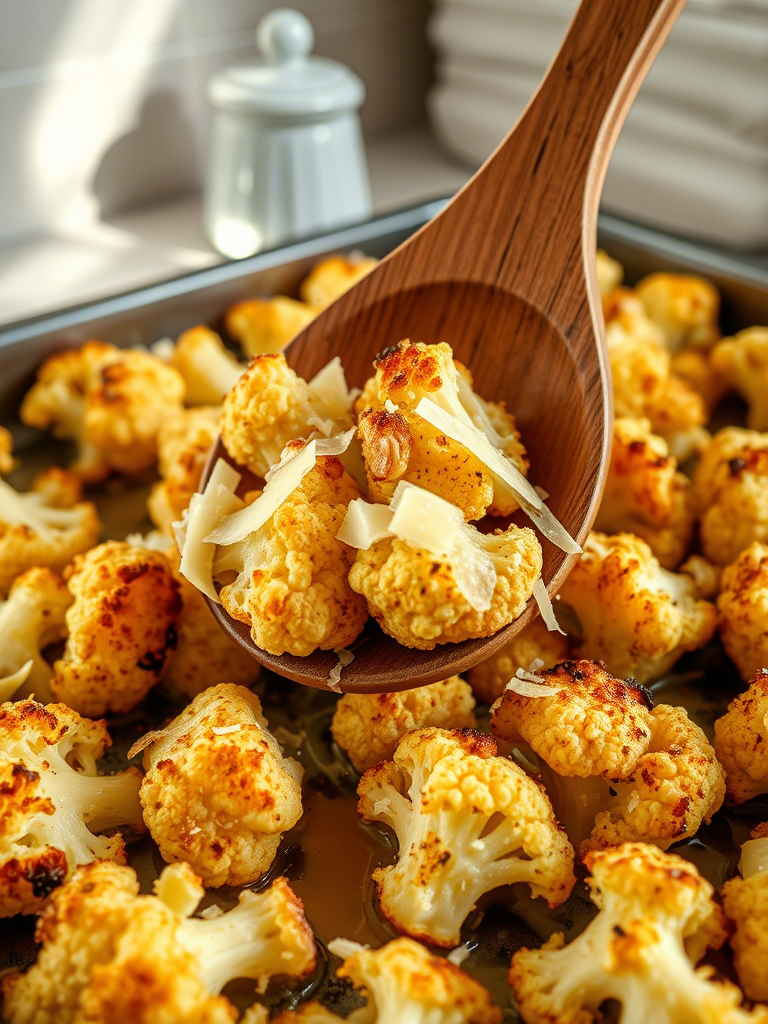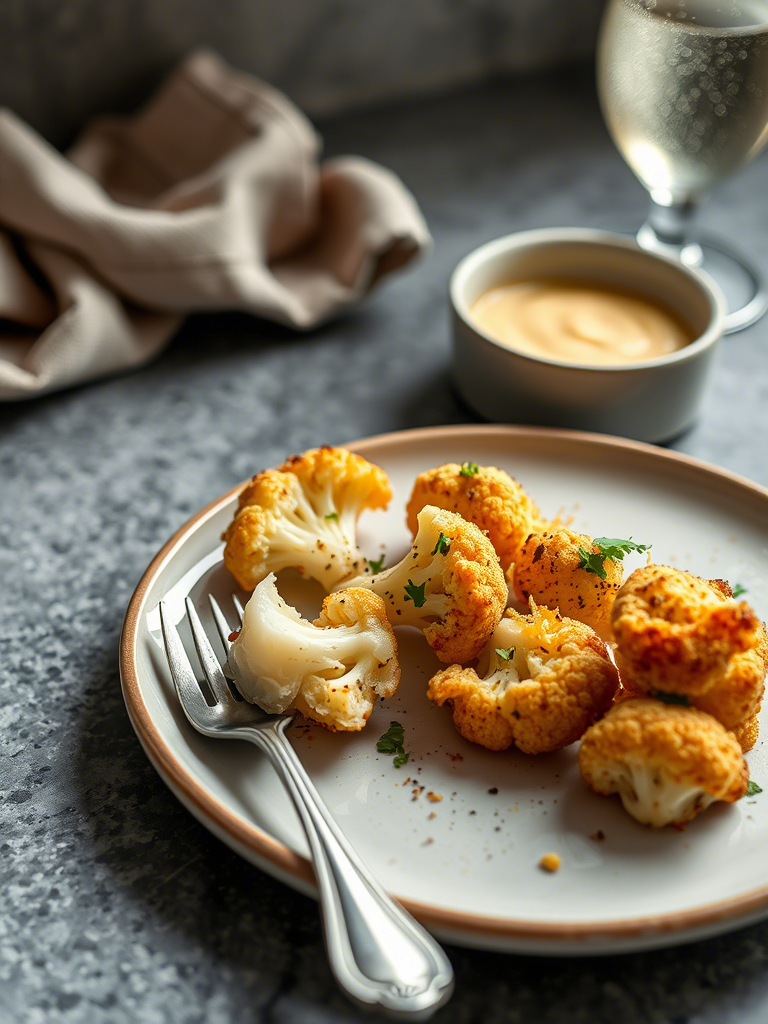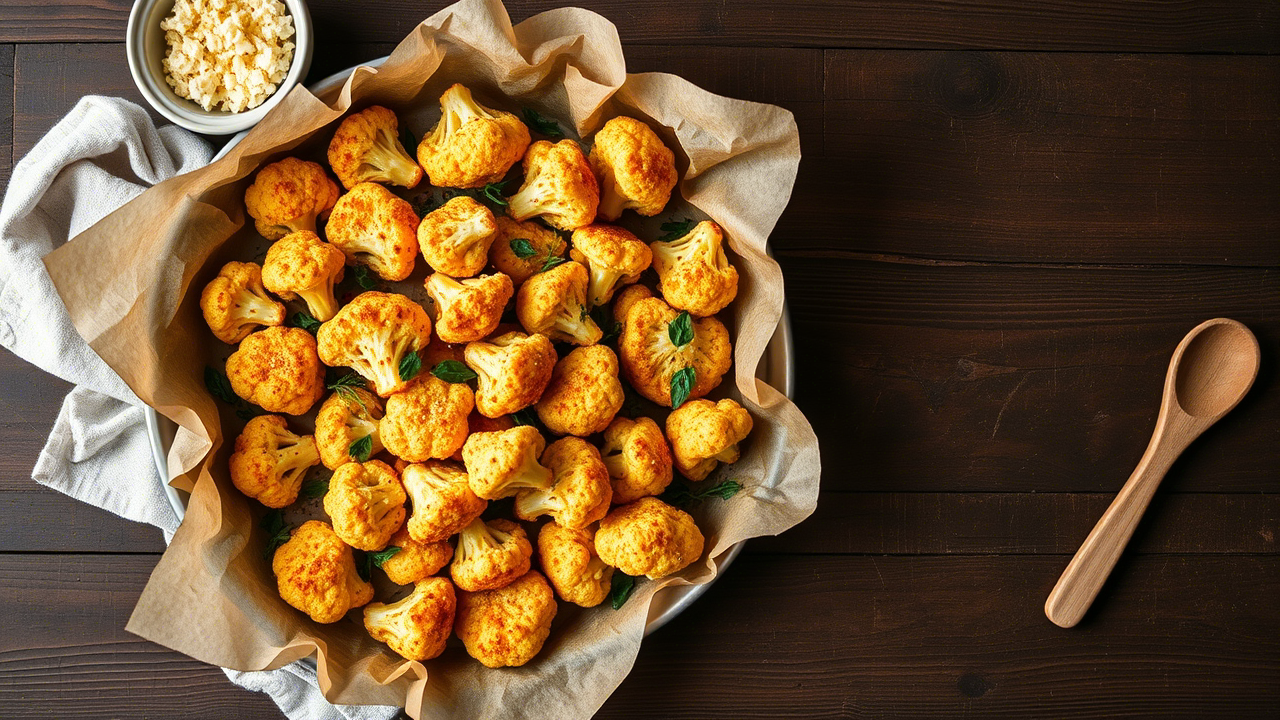There’s a certain kind of kitchen magic that happens when cauliflower meets heat, salt, and cheese. Not the steamy, mushy mess you might remember from your grandma’s boiled-to-death version. No, we’re talking about Crispy Parmesan Roasted Cauliflower—the kind of side dish that never makes it to the table because it’s picked clean off the sheet pan by greedy fingers before dinner is even served.
If you’re a pro in the kitchen or someone who lives and breathes restaurant prep lines, this is your cue to stop underestimating cauliflower. With the right touch of high-temp roasting, good quality cheese, and a couple chef’s tricks, this humble veggie turns into a golden, umami-loaded crowd favorite. It ain’t just a health trend. It’s good cookin’.
Let’s dig in.
Why This Recipe Deserves a Permanent Spot in Your Arsenal
Roasting cauliflower isn’t new. But crispy Parmesan roasted cauliflower is the kind of dish that walks the fine line between comfort food and high-end vegetarian elegance.
It checks boxes for:
- Texture (crispy edges, soft interiors)
- Deep flavor (Maillard reaction, baby)
- Crowd-pleasing simplicity
Roasting cauliflower at high heat drives off moisture and concentrates flavor, giving the florets that almost fried-like crunch on the outside. Parmesan, with its nutty and salty profile, takes it up a whole other level. Add aromatics like garlic, some fresh herbs, maybe a dash of smoked paprika or lemon zest if you’re feelin’ frisky, and now you’ve got something that plays on any menu.
This recipe isn’t just dinner table filler. It’s the dish that people text you about next week.
The Science of Roasting: How Cauliflower Becomes Crispy Gold
To get that golden crust, you’ve gotta understand what’s happening inside your oven. It’s not just heat—it’s controlled dehydration.
Roasting triggers the Maillard reaction, that tasty chemical dance between amino acids and sugars. But—and this is key—moisture is the enemy. You can’t get crispiness if your florets are steaming.
So here’s what you need to do:
- Dry those florets like your reputation depends on it. After washing, let them sit out on a towel. Maybe even pat them down again right before roasting.
- Use high heat. I’m talkin’ 425°F (218°C) or even 450°F. Anything lower, and you’re just teasing the cauliflower. We want commitment.
- Don’t overcrowd. Give ‘em room to breathe. If they’re touching, they’re steaming. And if they’re steaming, they’re not browning.
Want to cheat a little? Preheat your sheet pan. Yep. Hot pan + hot oven = jumpstart on browning.

Ingredient Deep Dive: What Makes or Breaks the Flavor
Sure, you could toss cauliflower in oil and cheese and call it a day. But if you want to turn heads, every component’s gotta pull its weight.
Cauliflower
Fresh, firm, and creamy-white. Avoid any with grey speckles or limp leaves. Organic, if you can swing it, often has better flavor depth.
Parmesan
Please. Don’t use the pre-shredded stuff in a green can. Real Parmigiano-Reggiano has sharpness, funk, and that umami wallop you can’t fake. Shred it yourself—thin and airy, like snowflakes of deliciousness.
Olive Oil
Cold-pressed extra virgin. You want it fruity and robust, not bitter or stale. A generous drizzle helps the cheese stick and the florets brown evenly.
Aromatics
Garlic powder, onion powder, cracked black pepper, maybe a pinch of red chili flakes if your crowd can hang. A little smoked paprika adds a subtle barbecue depth. And fresh parsley or thyme post-roast gives color and a pop of brightness.
Optional: Lemon Zest or Panko
Lemon zest? Yep, a microplane swipe over the final dish adds fresh zing. And if you’re after next-level crispiness, a sprinkle of panko breadcrumbs mid-roast will blow minds. Just don’t overdo it.
Step-by-Step Instructions (Because Technique Matters)
Here’s the blueprint. Nail the steps, and the results will slap.
Ingredients:
- 1 large head cauliflower, cut into florets
- 3 tbsp olive oil (plus more if needed)
- ¾ cup finely grated Parmigiano-Reggiano
- 1 tsp garlic powder
- ½ tsp onion powder
- ½ tsp smoked paprika (optional)
- Salt and pepper to taste
- Fresh parsley, chopped (for garnish)
- Lemon zest (optional)
Instructions:
- Preheat oven to 425°F (218°C). Place a large, rimmed baking sheet inside while it heats.
- Trim and dry cauliflower florets. No damp bits. Toss in a large bowl.
- Drizzle with olive oil. Add garlic powder, onion powder, paprika, salt, pepper, and toss until coated.
- Add Parmesan. Toss again, making sure cheese sticks to all surfaces.
- Transfer to hot baking sheet. Spread in a single layer. Don’t crowd.
- Roast 25–30 minutes. Flip once halfway. You want crispy edges and caramelized surfaces.
- Remove and garnish with parsley and lemon zest. Serve immediately. Eat with fingers. No shame.

Pro Tips from the Line
Let me level with you. I’ve made this dish at home, at pop-ups, and even during private chef gigs where nothing less than perfect flies.
Some tricks I swear by:
- Sheet Pan Lining: Use parchment, not foil. Cheese sticks to foil like regret to a bad tattoo.
- Dual Cheese Hack: Blend Parmesan with a touch of Pecorino Romano for extra sharpness.
- Finish Under Broiler: Last 1–2 minutes under the broiler? Dangerous. But worth it. Watch it like a hawk.
And here’s the kicker: this dish holds well at room temp. That means it’s killer for catering, buffets, or make-ahead prep.
Nutrition, Dietary Considerations, and Adaptations
Cauliflower is low-carb, high-fiber, and nutrient-dense. A solid source of:
- Vitamin C
- Vitamin K
- Choline
- Antioxidants
Paired with Parmesan, it brings in protein and healthy fats. For keto dieters? Slam dunk. For vegetarians? Safe zone. For vegans? Not quite, but you could swap in nutritional yeast and almond meal to mimic flavor and texture.
Gluten-free? Yep. Just skip any breadcrumb add-ons or make sure they’re GF certified.
Wanna go Mediterranean? Add za’atar. Indian-inspired? A pinch of garam masala works wonders.
Trends in Roasted Vegetable Dishes: What the Data Says
According to a 2024 Whole Foods Market trends report, cauliflower remains one of the top five vegetables purchased across North America. With plant-based dining growing over 300% globally in the past decade, roasted vegetables like this one are becoming more than just side dishes—they’re main event material.
Uber Eats and DoorDash reports from Q1 2025 show “crispy cauliflower” as one of the most searched side items after fries. And Google Trends? Searches for “roasted cauliflower Parmesan” have doubled since last year.
That tells us this ain’t a fad. It’s a movement. Restaurants, caterers, and chefs: pay attention.
Common Pitfalls and How to Dodge ‘Em
You’d be surprised how many ways people mess up cauliflower. Here’s a rapid-fire checklist:
- Too wet? Steams instead of crisps.
- Crowded pan? Same result—soggy sadness.
- Low heat? You’re just drying it out, not caramelizing.
- Wrong cheese? Pre-grated has anti-caking agents. Doesn’t melt right.
- No seasoning? Blandville, population: your dish.
One more thing: don’t toss the cauliflower too early in Parmesan. Oil first. Let it stick. Then cheese. Otherwise, the cheese burns before the veg cooks. And that’s just depressing.
Beyond the Side Dish: Use It Everywhere
This ain’t just a side dish, either. Think outside the pan.
- Toss it into a warm grain bowl with farro, chickpeas, and tahini dressing.
- Layer it in a wrap with hummus, arugula, and pickled onions.
- Add it to a charcuterie board. Cold, crispy cauliflower with olives, nuts, and spicy mustard? Game-changer.
You can even blend leftovers into a soup base with a bit of stock and cream. Boom. Creamy roasted cauliflower bisque.
Final Thoughts: What Crispy Parmesan Cauliflower Really Teaches Us
At its core, this recipe isn’t just about cauliflower. It’s about technique. About the power of high heat and good ingredients. About how a once-boring vegetable can transform into something unforgettable with a few deliberate moves.
Professionals in the kitchen—this is your reminder that simple doesn’t mean basic. The layers of flavor, the textural contrast, the visual appeal—all that happens with five or six pantry ingredients and a solid understanding of heat and spacing.
Try it. Tweak it. Own it.
And remember—if it ain’t crispy, you ain’t done yet.
FAQs
What temperature is best for roasting cauliflower to get it crispy?
425°F (218°C) is ideal to ensure caramelization and crispy edges.
Why is my roasted cauliflower coming out soggy?
Too much moisture or overcrowding on the pan causes steaming instead of roasting.
Can I use frozen cauliflower for this recipe?
Yes, but thaw and dry it thoroughly first to avoid sogginess.
Is pre-grated Parmesan okay to use?
Avoid it—it often has anti-caking agents that prevent proper melting and crisping.
Can I make this recipe vegan?
Yes, swap Parmesan with nutritional yeast and almond flour for a similar effect.
How do I reheat leftover roasted cauliflower?
Reheat in a hot oven or air fryer to regain crispiness—avoid microwaving.
Can I make this ahead for meal prep?
Absolutely, it holds up well at room temp and tastes great cold or reheated.
What other cheeses can I use besides Parmesan?
Pecorino Romano or Grana Padano are great sharp substitutes.
Can I add breadcrumbs for extra crunch?
Yes, a sprinkle of panko halfway through roasting adds texture.
What are good herbs or spices to add?
Try garlic powder, smoked paprika, thyme, parsley, or even za’atar for variation.

Mariana is a passionate home cook who creates delicious, easy-to-follow recipes for busy people. From energizing breakfasts to satisfying dinners and indulgent desserts, her dishes are designed to fuel both your body and hustle.
When she’s not in the kitchen, she’s exploring new flavors and dreaming up her next recipe to share with the Foodie Hustle community.

